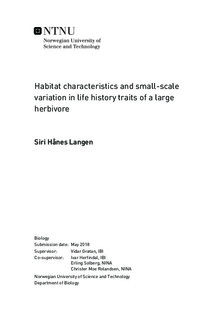Habitat characteristics and small-scale variation in life history traits of a large herbivore
Master thesis
Permanent lenke
http://hdl.handle.net/11250/2503072Utgivelsesdato
2018Metadata
Vis full innførselSamlinger
- Institutt for biologi [2596]
Sammendrag
Identification of habitat characteristics shaping small-scale variation in life history traits is important for our understanding of the magnitude of small-scale resource utilisation for different life history traits. Based on data collected from 74 hunting units in two municipalities in central Norway, I examined geographical variation in two life history traits of moose, early-life body mass based on carcass mass of calves and yearlings shot during the autumn hunt and twinning rate from hunter observations. Spatial variation in these life history traits was subsequently analysed to determine the most important habitat characteristics influencing life history traits. Additionally, I investigated whether there was a trade-off between offspring quantity and quality, and whether this influenced the habitat-performance relationship for the different life history traits. Both early-life body mass and twinning rate exhibited spatial variation and there was positive covariation between these traits. The presence of agricultural areas in the hunting units was found to be the most important habitat characteristic, and both yearling body mass and twinning rate was positively related to the proportion of agricultural areas in the hunting units. This was most likely due to the high abundance of plants with high nutritional status in such areas. In contrast, the life history traits in general, and calf carcass mass in particular, were negatively related to the proportion of habitats assumed to be of poor nutritional quality. Accounting for the effects of habitat characteristics, the calf body mass was not related to twinning rate. This indicate that females in good habitats produce twins at a higher rate, and that these also become large the following autumn. However, the data did not allow to test whether the higher autumn body mass of calves in good areas with a high twinning rate was caused by larger birth weight or a higher growth rate from birth to autumn. The results indicate that geographical variation in habitat composition can explain small-scale variation in life history traits and that especially agricultural areas are important for early-life body mass and twinning rate. However, the trade-off between offspring quantity and quality seems to weaken the habitat-signal on calf body mass.
